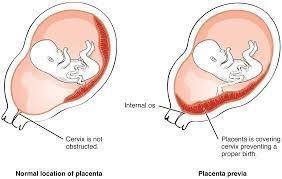A nurse is collecting data from a client who has placenta previa. Which of the following findings should the nurse expect?
Bright red vaginal bleeding
Rigid abdomen
Increased fetal movement
Persistent uterine contractions
The Correct Answer is A
Placenta previa is a condition where the placenta partially or completely covers the cervix, leading to vaginal bleeding. The bleeding is typically painless and bright red in color. This is an important finding that should be assessed and monitored closely.

A rigid abdomen is not a characteristic finding of placenta previa. It could be a sign of another condition such as placental abruption or uterine rupture, which are separate complications. Fetal movement is not directly related to placenta previa. It is a normal finding and can vary depending on the gestational age and individual fetal patterns.
Placenta previa is not typically associated with persistent uterine contractions. However, it is important to monitor for any signs of preterm labor or other complications that could cause uterine contractions.
Nursing Test Bank
Naxlex Comprehensive Predictor Exams
Related Questions
Correct Answer is C
Explanation
Choice A: While nitroglycerin is a common medication for angina, calling the provider after just one dose is not the recommended action. Nitroglycerin helps relax coronary arteries and improve blood supply to the heart. However, if chest pain persists, the client should follow additional steps..
Choice B: This describes the Valsalva maneuver, which involves holding the breath and bearing down as though straining to initiate a bowel movement. While this technique can regulate heart rhythms and help the ears to pop, it is not the recommended response to chest pain from angina.
Choice C: Correct: This statement demonstrates an understanding of appropriate action. When experiencing angina, the client should stop any physical activity, sit down, or lie down. Resting helps reduce the heart’s workload and allows blood flow to stabilize.
Choice D: Aspirin can be beneficial during angina episodes. However, the recommended dose is usually 162 to 325 milligrams (one tablet). Taking two tablets at once may not be necessary unless specifically advised by a healthcare provider.
Correct Answer is ["A","B","D"]
Explanation
The nurse should take the following actions when receiving a telephone prescription from a client's provider:
- Ask the provider to spell out the name of the medication: This is important to ensure accurate transcription of the medication name. Spelling out the name helps prevent errors due to similar-sounding medications or confusion with abbreviations.
- Request that the provider confirm the read-back of the prescription: This step ensures that the nurse and the provider are on the same page and that the prescription has been accurately transcribed. It allows for verification and correction if any discrepancies are identified.
- Record the date and time of the telephone prescription: Documenting the date and time of the telephone prescription is essential for tracking and reference purposes. It helps establish a clear timeline of events and ensures proper documentation of the medication order.
It is not necessary to withhold the medication until the provider signs the prescription, as telephone prescriptions are typically followed up with a written prescription or electronic verification.
Instructing another nurse to record the prescription in the medical record may not be necessary, as the nurse who received the telephone prescription is responsible for accurately documenting the order in the medical record. However, if necessary, the nurse can delegate the task of documentation to another qualified staff member under their supervision, ensuring accuracy and completeness.
Whether you are a student looking to ace your exams or a practicing nurse seeking to enhance your expertise , our nursing education contents will empower you with the confidence and competence to make a difference in the lives of patients and become a respected leader in the healthcare field.
Visit Naxlex, invest in your future and unlock endless possibilities with our unparalleled nursing education contents today
Report Wrong Answer on the Current Question
Do you disagree with the answer? If yes, what is your expected answer? Explain.
Kindly be descriptive with the issue you are facing.
